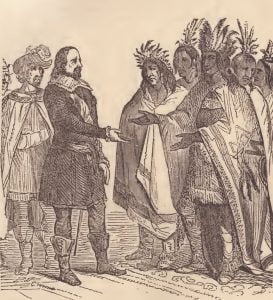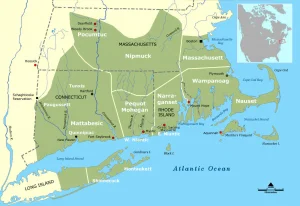The history of the settlers of New England is fraught with the troubles of Indian hostilities. This is a history of the early Indian wars in New England.
In 1620, a company belonging to Mr. Robinson’s church, at Leyden, in Holland, foreseeing many inconveniences likely to increase, from the residence of English dissenters under a foreign government, and hoping to find an asylum, and a refuge from persecution in the New World, applied to King James for liberty to place themselves in some part of New England; and obtained a grant of some place about Hudson river. They set sail from Plymouth, in September, and after a boisterous passage found themselves in Massachusetts Bay, considerably to the north of their destination. But the approach of winter, and other causes, forced them to land at the nearest convenient spot, and on the 22d of December, 1620, they disembarked upon the spot afterwards called Plymouth. The settlers numbered one hundred and one persons. After this beginning, other settlements were established at favorable points on the coast.
The principal tribes in the neighborhood of the settlers were the Pequods, the Mohicans, the Narragansetts, and the Wampanoags. Some of these Indians displayed their hostility soon after the settlement was begun at Plymouth; but the majority of them seemed disposed to friendship. On the 16th of March, 1621, the whites were surprised by an Indian coming boldly alone into Plymouth, and crying out, “Welcome, Englishmen! welcome, Englishmen!” He was the Sagamore of a neighboring tribe, and named Samoset. He had learned to speak broken English from the fishermen, who came to the coast. Through his influence, a treaty was concluded with Massasoit, the greatest king of the surrounding country, and it was observed by him for fifty years.
The Narragansetts early manifested enmity to the English; but were daunted by the resolution and activity of Miles Standish and his few men. Massasoit revealed a plot of the Massachusetts Indians to attack the settlers at Wessagusset; and Standish, taking with him eight men, proceeded to the place where the conspirators met, and killed them all. A skirmish with a party of Indians followed, in which they were put to flight. The Wessagusset settlers, however, abandoned that place and returned to Plymouth. The Indians were awed by this prompt display of power they wanted a Philip to teach them their strength.
The Pequot War
As the number of settlements increased, and spread to Connecticut and Massachusetts, the hostility of the Indians was awakened. Several schemes of Miantonimo, the chief of the Narragansetts, were detected, and their execution prevented. All the Indians east and west of the Connecticut River, except the Pequods, became tributary to the first settlers of Connecticut. The Pequods had spread their conquests over a vast extent of country, and were superior to all other tribes except the Narragansett. Between these two, a deadly feud existed. Sassacus was the first chief of the Pequods known to the English. He considered the settlers as invaders of his country, and was at all times anxious to repel them.
It is not surely ascertained which party gave the provocation which led to the Pequod war. The English relate that the Pequods murdered the captain and crew of a vessel which sailed into the Connecticut River, in 1633. The Indians admitted the murder, but asserted that Captain Stone had taken two of their men by force, to pilot his vessel up the river. This matter, however, was amicably settled by treaty. Other outrages followed, the perpetrators taking refuge among the Pequods, who would not yield them upon demand of the English. The governor of Connecticut then sent Captain John Endicott, with ninety men, against them. On the arrival of Endicott in the Pequod country, the Indians retreated into a swamp, where it was difficult to come at them. Only two were killed, but the English burned their wigwams, and then concluded a treaty with the Narragansetts, who could bring five thousand fighting men into the field.
The Pequods, emboldened by Endicott’s failure, continued their predatory incursions. They killed several men and women, and a large number of cattle. The colony determined to make another and a greater effort to stop their proceedings. In the month of May, 1636, a force from Connecticut, under John Mason, consisting of ninety Englishmen, and about seventy Mohicans, under the command of the sachem, Uncas, departed for the Pequod country. Arriving at Saybrook, Mason sent back part of his men to protect the settlements on the Connecticut. He was soon afterwards joined by a great number of Indians; so that when he set out, he was at the head of nearly six hundred men. He arrived in sight of the fort erected by the Pequods, about sunset. The Narragansetts could not be persuaded to attack an enemy in a fort; and a portion of them retired, while the rest formed themselves into a semi-circle at some distance, to intercept such Pequods as should escape the English.
Mason approached the fort just before daybreak. It would have been surprised but for the barking of a dog, which roused the garrison to a knowledge of its danger. They made a vigorous resistance, and the assailants were finally obliged to set fire to the fort. The Pequods then rushed through the flames to escape, but were nearly all killed. Between five and six hundred of them perished in the battle. The English lost two men killed, and sixteen were wounded. Sassacus, who was in another fort, hearing of the battle, sent three hundred men to assist his countrymen. This body was encountered by Mason, and obliged to retire to the top of the hill on which the fort had stood. On seeing its ruins, they became so enraged, that they lost all fear, and rushed down upon the English with such force, that the latter were compelled to make a rapid retreat of six miles, when they reached their vessels and returned to Hartford.
The three hundred Pequods returned to Sassacus. A council was then held, and it was settled, that the tribe could no longer remain in safety in the country. Accordingly, they dispersed, and Sassacus, having destroyed the village, proceeded towards the Hudson River. Hearing of Mason’s brilliant success, the governor of Massachusetts sent an expedition to destroy all straggling parties which might remain in the neighborhood. A great battle was fought at a swamp in Fairfield, in which a large number of the savages were killed, and about two hundred taken. Sassacus, however, was destined to meet his death from the red man’s hand. He fled to the country of the powerful Mohawks.

These Indians, instead of protecting him, put him to death, and sent his head to Connecticut. The few Pequods who remained alive, took refuge among the surrounding tribes, and their nation lived but in memory.
The destruction of this large and powerful tribe was the only measure which could secure the colonists from their constant hatred and annoyance, between the white and the red man, it was a struggle for self-preservation, and an unbiased judgment will consider the circumstances in which the colonists were placed before condemning them for unnecessary cruelty. The fate of the Pequods was a terrible one but it served a very important purpose in striking awe upon the other tribes; and there is no reason to doubt, that the dreadful massacre of this tribe was instrumental in preserving the long peace which intervened between that event and the terrible war with King Philip, which will form the subject of the next chapter.

